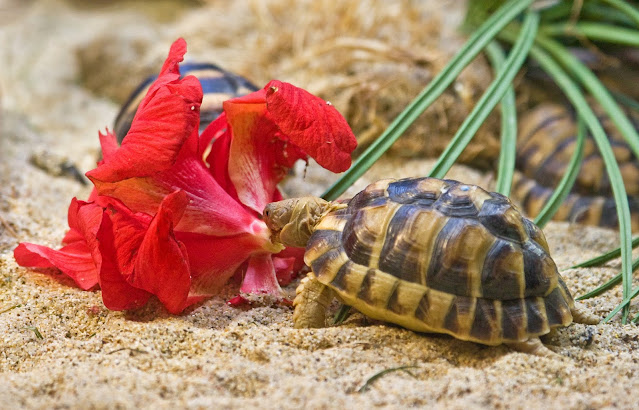Posted by Elizabeth Bacher, Communications
 |
| Egyptian tortoises are critically endangered. Photo: Jeremy Dwyer-Lindgren/Woodland Park Zoo |
Every now and then, the world’s tiniest creatures show they have something big to teach us, if we’re willing to listen. Such is the case for the Egyptian tortoise. This critically endangered species, one of the world’s smallest tortoises, faces intense pressure in the wild. They’re native to the desert bordering the Mediterranean Sea and were once found in Libya, Egypt and Israel. Now, they’re isolated to small patches of territory in Libya and are considered extinct in the rest of their territory. Habitat destruction and human encroachment, including the illegal pet trade, are to blame. But there is hope, in the form of tiny hatchlings that weigh about as much as a couple nickels.
 |
| At hatching, Egyptian tortoises weigh only about 10 grams—the same weight as a couple nickels. Photo: Ryan Hawk/Woodland Park Zoo |
Unlike many turtles and tortoises, which are various shades of green, the Egyptian tortoise has a sand or brownish- colored shell. It’s a great adaptation to help them blend in with their native desert habitat. When they hatch, these babies are tiny, weighing only 10 grams. That’s not even half an ounce! Even full grown, Egyptian tortoises are small, with adults rarely getting more than 4 to 4.5 inches long from the front edge of the shell to the back—and the females tend to be bigger than the males.
 |
| Our Egyptian tortoises love feasting on fresh produce! Photo: Dennis Dow/Woodland Park Zoo |
Our Egyptian tortoises live in several areas around the zoo, including the Adaptations Building on the zoo’s east side. If you’re visiting, you can find one group of them there living side-by-side with some lizards. Another group is part of our Ambassador Animals team. That means they take part in educational programs, helping guests to learn about them and promoting ways to take action for wildlife. Tut and Ramses (both 13 years old) along with Nile and Cairo (both 6) all hatched here as part of the SSP and are all part of the Ambassador Animals team.
Tortoises (and turtles in general) are often thought of as slow, passive or lethargic. Apparently, no one told that to our Ambassador group! These bachelors (they’re all male) love to zoom around—and they come running when we give them their favorite in-between meals snack: hibiscus flowers! YUM! All of these boys share a warm behind-the-scenes habitat, where they get along really well. Each of their shells has a slightly different pattern, so our animal keepers can tell them apart, but they also have tiny markers on their shells— small dots with numbers—so that team members can easily identify and care for each one.
In order to assure a safe and healthy experience, many of our in-person programs, including those with ambassador animals, are temporarily on hold right now—but that doesn’t mean you can’t meet our ambassador tortoises! Woodland Park Zoo’s new Wild Meet and Greet program allows you and a small group of family or friends are invited to have an up close experience with one of our extraordinary animals.
Today, more than 50 percent of the world’s known tortoise and turtle species are facing extinction, making these reptiles one of the most endangered animals on the planet. Woodland Park Zoo is more committed than ever to protecting all these species, around the world and here at home—and we invite you to join us!
 |
| Our Egyptian tortoises love munching on hibiscus flowers! YUM! Photo: Dennis Dow/Woodland Park Zoo |
- Promise never to buy or sell pets if you don't know where they came from. The illegal pet trade is no good for turtles, tortoises and other wildlife, so if you’re purchasing pets, make sure they’re from a vetted source and never buy or sell endangered species.
- Keep your local wetlands clean and healthy! Don't dump chemicals down the drain and cut down on pesticides in your yard that can run off into the street and eventually make its way to streams, rivers and the Puget Sound.
- Advocate for protecting endangered species and support laws that save vulnerable species from harm including wildlife trade, poaching and habitat loss.
- Support your local zoo, conservation programs and habitat restoration projects.

Comments
Post a Comment